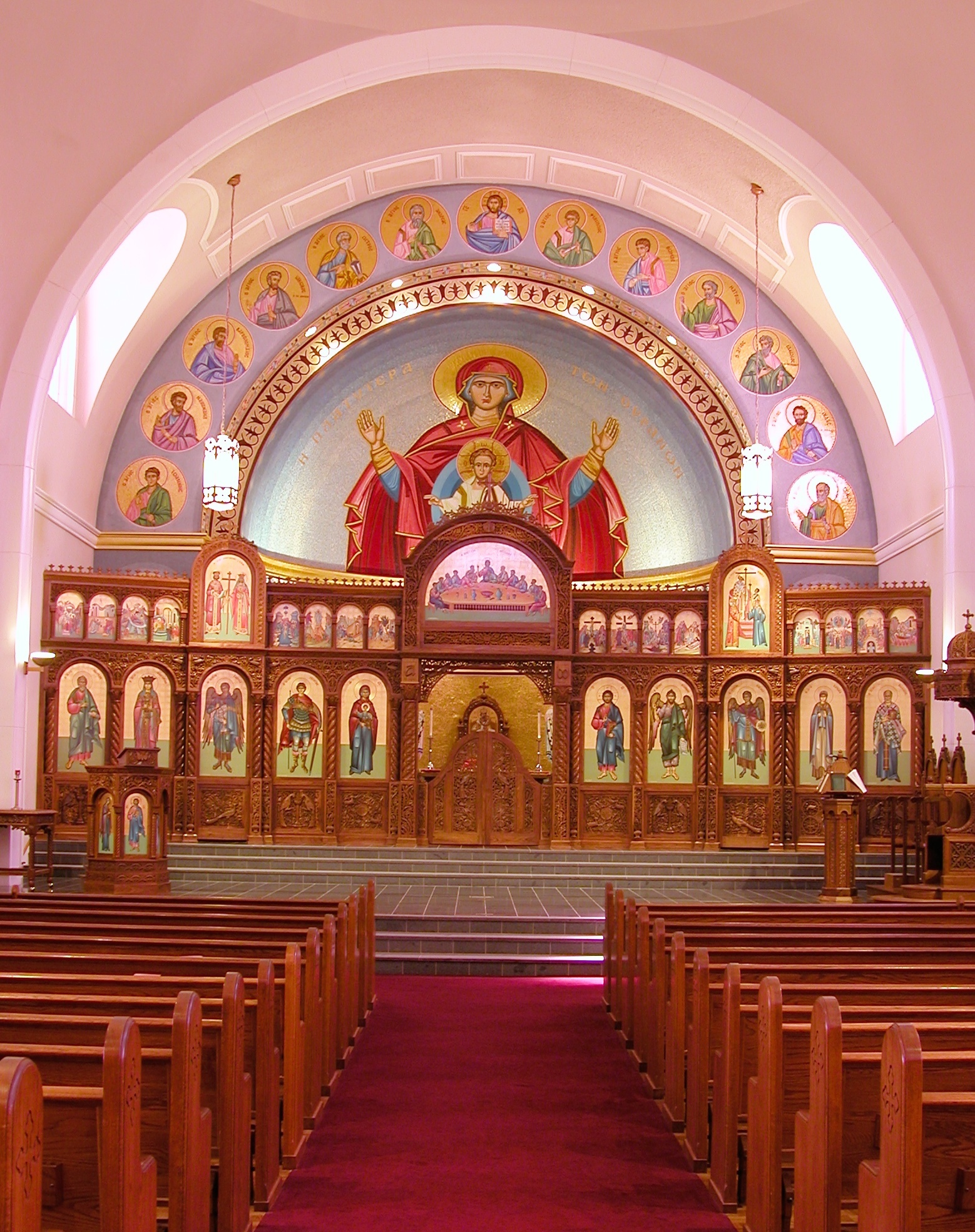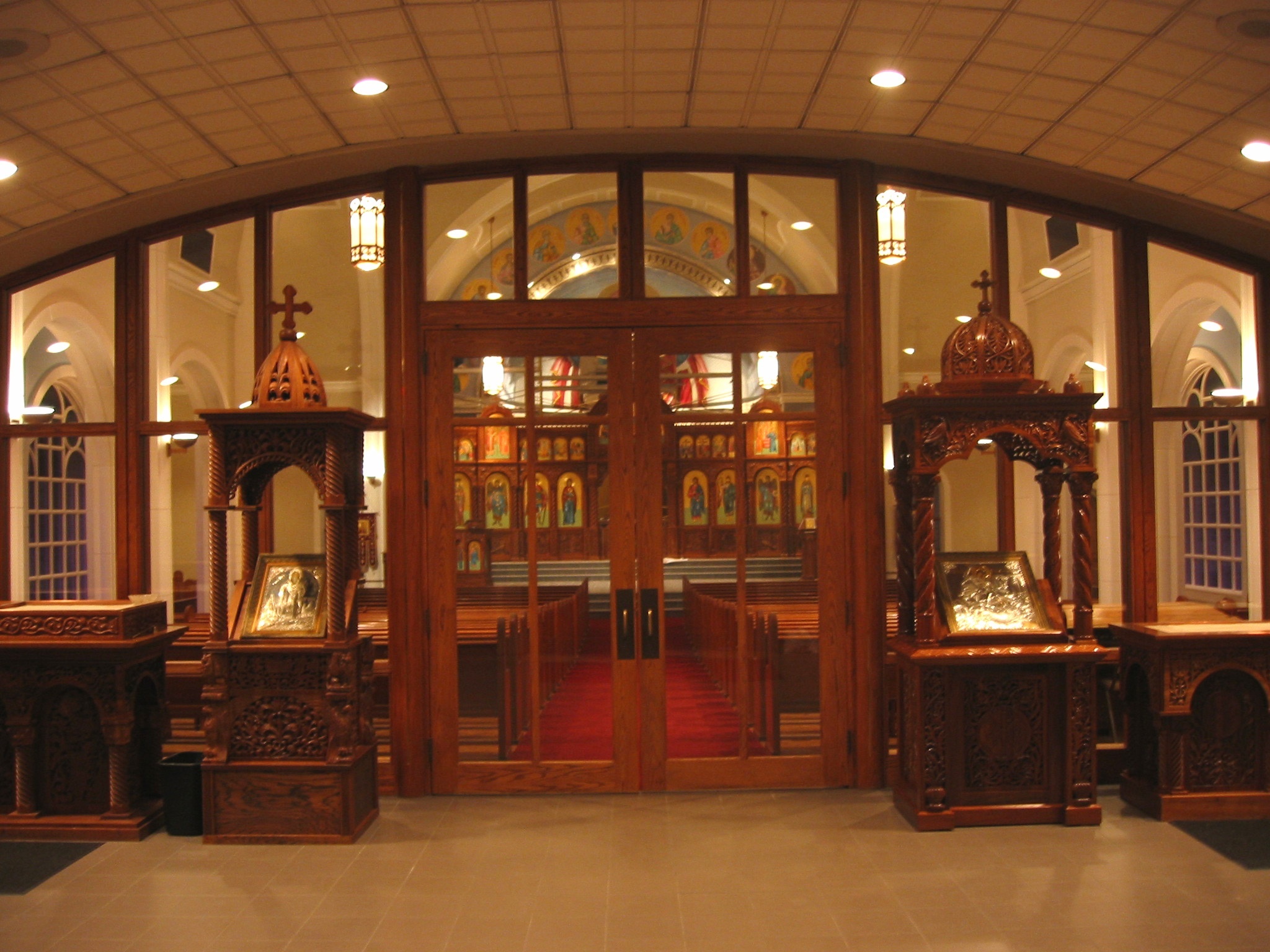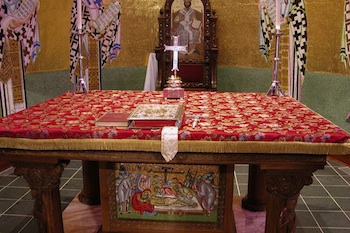The Church Building
A church, or temple, is a building consecrated to God and intended for divine worship. The Lord is invisibly present in the church and receives our prayers there; as He said: "Where two or three are gathered together in My name, I am there in the midst of them" (Matt. 18:20). Since "the powers of heaven invisibly serve with us" in the church, it may be considered a bit of heaven on earth or an island of the kingdom of heaven.
During the first three centuries of Christianity, because of the relentless persecutions, Christian church buildings were rare. Only after the proclamation of religious freedom by Emperor Constantine the Great in 313 did Christian churches begin to appear everywhere.
Initially, churches were built in the form of a basilica — a long rectangular building with a small projecting structure at the entrance (the portico or porch) and a curved apse at the opposite end. Rows of columns divided the interior of the basilica into three or five sections called naves (meaning "ships"). The central nave was higher than those on the sides and had windows in it. Such basilicas were characterized by an abundance of light and air.
Soon churches were being built in other forms as well. Beginning in the fifth century, there were churches built in Byzantium in the form of a cross, with arches and a dome or cupola over the central part of the church. Occasionally, but more rarely, round or octagonal churches were built. The church architecture of Byzantium had an enormous influence on the Orthodox East
Orthodox Church buildings today are full of
icons, but the very architecture and layout of the
buildings are themselves icons of the Church. In the
ornamentation of the church, the various iconographical
scenes and figures are not arranged by chance, but
according to a definite theological scheme, so that the
whole edifice forms one great image of the Kingdom of God.
 The Orthodox faithful can feel the
building open up to a time without end. They are
surrounded by the images of Christ, the
angels, and the saints, and are reminded of
the invisible presence of the whole community
of heaven at the Liturgy. Each local congregation,
in their church building, can see that their Liturgy
on earth is one and the same with the great Liturgy
of heaven.
The Orthodox faithful can feel the
building open up to a time without end. They are
surrounded by the images of Christ, the
angels, and the saints, and are reminded of
the invisible presence of the whole community
of heaven at the Liturgy. Each local congregation,
in their church building, can see that their Liturgy
on earth is one and the same with the great Liturgy
of heaven.
The building should help the faithful lay aside
their earthly cares, as the Liturgy is celebrated, so that
they, like the cherubim, may welcome the King of all .
In the Old Testament, the Lord Himself directed mankind through the Prophet Moses, indicating the way to set up the Temple for divine worship. The churches of the New Testament are constructed on the basis of the Old Testament Temple.
Just as the Old Testament Temple (initially a tent) was separated into three portions: the Holy of Holies, the Sanctuary and the Courts; an Orthodox church is distinguished by three corresponding sections: the Altar (or Sanctuary), the Nave, and the Narthex (Vestibule).
As the Holy of Holies signified in the Old Testament Temple, the Altar represents now the Kingdom of Heaven. In those times, no one could enter the Holy of Holies except the High Priest, and even he only once a year with the blood of purification. This signified that the Kingdom of Heaven, after the fall of man into sin, was closed to man. The High Priest was a prototype of Christ, and his action foretold that a time would come when Christ, through His shedding of blood, suffering on the Cross and Resurrection, would open the Kingdom of Heaven to all. Therefore, when Christ died on the cross, the veil of the temple which closed off the Holy of Holies was torn in two. From that moment on, Christ has opened the gates to the Kingdom of Heaven, for all who with faith would come unto Him.
The Sanctuary of the Temple corresponds in an Orthodox church to the Nave, the middle part of the building. No one had the right to enter the Old Testament sanctuary except the priest; yet all believing Christians may stand within the Nave of the church because the Kingdom of God is closed to none.
The Courts of the Old Testament Temple in which all the people could gather have their counterpart in the Narthex of an Orthodox Church. However, the Narthex has no essential significance today, though in earlier times catechumens who were preparing to become Christians, but not ready for the Mystery of Baptism, stood there. Today, those who have sinned grievously, or those who have apostatized from the Church, are sent to stand in the Narthex temporarily for correction.
An Orthodox Church is built with the altar at the eastern end, directed towards the light from whence the sun rises. The Lord Jesus Christ is for us the "Dayspring," for from Him has dawned upon us the eternal Divine Light. In the church prayers, we also call Jesus Christ the "Sun of Righteousness" and the "Dayspring from on high."
Every church consecrated to God bears the name of a sacred event or Saint, in memory of that occasion or person. For example, churches are dedicated to the Trinity, the Transfiguration, the Ascension, the Annunciation, the Protection of the Mother of God, the Archangel Michael, St. Nicholas, and so forth. If there are several altars in the church, each of them is dedicated to the memory of a different event or saint. All altars, save the main one, are called side altars.
A church in its external appearance is distinct from other buildings. Most churches are designed in the form of the Cross; this signifies that the church is a place sacred to Him Who was crucified for us, and that the Cross of the Lord Jesus Christ delivered us from the tyranny of the Devil. A church may also be built in the form of an elongated ship, to represent the image of the ark of Noah, for the church brings us through the stormy sea of life to the calm haven of the Kingdom of Heaven. Sometimes a church is built in the form of a circle, to remind us that the Church of Christ is eternal, without beginning or end. A church can even be built in the form of an octagon, suggesting that the Church, like a star, guides us by shining into this world.
A church building is usually capped by a dome, which is an image of Heaven. The dome comes to a point crowned by a cross, to the glory of the head of the Church, Jesus Christ. Often a church is topped by several cupolas. Two cupolas symbolize the two natures of Jesus Christ, human and divine; three, the three Persons of the Holy Trinity; five, Jesus Christ and the four Evangelists; seven, the seven Mysteries and the seven Ecumenical Councils; nine, the nine ranks of angels; thirteen, Jesus Christ and the twelve Apostles. Sometimes there are churches found with even more cupolas. Over the entrance of the building, or at times next to it, a belltower or belfry is built to hold the bells.
Different patterns of ringing the bells are used to call
the faithful to prayer and to the divine services; they
also mark when the most important moments of the services
are being conducted. The ringing of one bell is called an
"annunciation"; it announces the good, joyous news of a
divine service. The ringing of all the bells is called a
"festive peal," and expresses Christian joy on the
occasion of a solemn feast. The tolling of bells on a
grievous occasion is called a "knell." The sound of bells
reminds us of the higher, heavenly world.
The three main parts:
 1.
The Narthex or Vestibule.
1.
The Narthex or Vestibule.
Here you find Candle and offering tables and the
Proskynetarion (shrine with Icon which we venerate after
lighting our candle and before going to our pew.)
Narthex-vestibule symbolizes this world. Services such
as those for baptism or wedding services start in the
vestibule.
 2. The
Church proper, or Nave (from the Greek word "Naus",
meaning ship.) Here are the Pews for the faithful, the
Pulpit, from which the Deacon reads the Gospel, and the
Sermon is preached, the Cleros which is the place on the
right where the Chanters and Readers stand and the
Bishop's Throne, used by the Hierarchy. The Nave is the
place of the assembled people of God. The faithful
Christians on earth who already belong to the holy
assembly enter into the eternal worship of God's Kingdom
in the Church.
2. The
Church proper, or Nave (from the Greek word "Naus",
meaning ship.) Here are the Pews for the faithful, the
Pulpit, from which the Deacon reads the Gospel, and the
Sermon is preached, the Cleros which is the place on the
right where the Chanters and Readers stand and the
Bishop's Throne, used by the Hierarchy. The Nave is the
place of the assembled people of God. The faithful
Christians on earth who already belong to the holy
assembly enter into the eternal worship of God's Kingdom
in the Church.
The
Iconostasion: The Church proper is separated from the
Sanctuary by the Iconostasion, which has a large central
Door, and two smaller doors on either side. The
Iconostasion is adorned with Holy Icons. Facing
the Holy Altar we see to the right of the Central Door,
the Icon of our Lord Jesus Christ; beside our Lord is
St. John the Baptist and to the right of St. John is the
Archangel Gabriel. To the left of the central Door we
see the Icon of the Virgin Mary holding the Christ
Child; next, on the left, is the Icon of the Patron
Saint of the particular Church; (by recognizing the
Saint or Saints in this position we establish the name
of the Church, without having to be told.) On the
left side of this Icon is the Icon of the Archangel
Michael. To the right or the left of these six
Icons, which are standard in the Orthodox Church, we add
other Icons by choice, if there is room.
The Solea: The open space between the Pews and the
Iconostasion is called Solea, which usually is
elevated. In this space all the litanies and
processions and Sacraments are performed.
 3.
The Sanctuary.
3.
The Sanctuary.
The Sactuary area stands for the Kingdom of God. The
altar table is where Christ is enthroned, both as the
Word of God in the Gospels and as the Lamb of God in the
Eucharistic sacrifice. Around the table are the angels
and saints in the perpetual adoration inspired by the
Holy Spirit.
The Sanctuary is built upon a raised portion that is usually higher than the other portions of the church, so that all that is done there can be seen and heard during the service. The very word "Altar" means an elevated place of sacrifice. No layman is permitted inside the Sanctuary unless he has a special office given to him by the Bishop, such as Acolytes or Readers.
